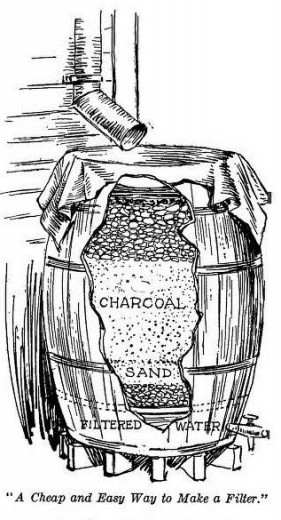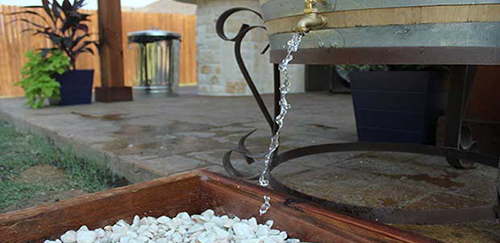During our boiling, broiling, blistering summer of 2012 here in the Missouri Ozarks, water was a topic of conversation wherever we went. Creeks and ponds dried up (some never recovered) and the water table dropped, forcing a few neighbors to have their well pumps lowered or to even have deeper wells drilled.
 Many folks shared memories of rain barrels, cisterns, hand pumps and drawing water with a well bucket as a child, usually on grandpa and grandma’s farm. Some said they’d never want to rely again on those old-time methods of getting water. But, at least they knew how it was done.
Many folks shared memories of rain barrels, cisterns, hand pumps and drawing water with a well bucket as a child, usually on grandpa and grandma’s farm. Some said they’d never want to rely again on those old-time methods of getting water. But, at least they knew how it was done.
It seems we have lost much practical knowledge in the last 50 or so years because we thought we’d never need it again. Now we are scrambling to relearn those simple know-hows.
A tattered, 4-inch thick, 1909 book I happily secured for $8 in a thrift store reveals, among umpteen-thousand other every-day skills, how to make homemade water filters. The instructions in “Household Discoveries and Mrs. Curtis’s Cookbook” are quite basic as everyone had a rain barrel back then and presumably knew how to clean the water. Now, 104 years later, I am thankful the authors had the foresight to preserve their knowledge for us, and pointed out that rainwater collected in barrels from a roof is a necessity in some locations, but also is best for laundry and “often more wholesome for drinking purposes than hard water.”
The “wholesome” observation applies to plants, too. I noticed during our 6-week dry spell (not a drop of rain) that I was only able to keep my vegetables alive with the garden hose – until our well, too, began sucking air. The pitiful potato, tomato and bean plants actually seemed petrified, like faded plastic decorations. Then, after a 2-hour rain shower, the plants miraculously leapt to life – vibrant, green and THRIVING. I did, too.
In early June last year, my husband surprised me with a 425-gallon water tank so I could water with nutritious rainwater, although it was August before any measure of water was in the tank. When the elusive rains finally paused briefly overhead, I was out in it with my 2-gallon watering can, running and sloshing the water like a crazy woman onto our neglected trees far up the hill.
100-Year-Old Instructions
 For gardening, rainwater is, naturally, best unfiltered. But, for household use, the vintage book says the following instructions yield a cheap and easy way to make a filter just as good as a patent filter costing 10 times as much:
For gardening, rainwater is, naturally, best unfiltered. But, for household use, the vintage book says the following instructions yield a cheap and easy way to make a filter just as good as a patent filter costing 10 times as much:
“Take a new vinegar barrel or an oak tub that has never been used, either a full cask or half size. Stand it on end raised on brick or stone from the ground. Insert a faucet near the bottom. Make a tight false bottom 3 or 4 inches from the bottom of the cask. Perforate this with small gimlet holes, and cover it with a piece of clean white canvas.
“Place on this false bottom a layer of clean pebbles 3 or 4 inches in thickness; next, a layer of clean washed sand and gravel; then coarsely granulated charcoal about the size of small peas. Charcoal made from hard maple is the best. (30 Survival Uses for Wood Ashes You Never Thought of)
“After putting in a half bushel or so, pound it down firmly. Then put in more until the tub is filled within 1 foot of the top. Add a 3-inch layer of pebbles; and throw over the top a piece of canvas as a strainer. This canvas strainer can be removed and washed occasionally and the cask can be dumped out, pebbles cleansed and charcoal renewed every spring and fall, or once a year may be sufficient.
“This filter may be set in the cellar and used only for drinking water. Or it may be used in time of drought for filtering stagnant water, which would otherwise be unpalatable, for the use of stock. This also makes a good cider filter for the purpose of making vinegar (see – Making Raw Apple Cider Vinegar at Home). The cider should first be passed through cheese cloth to remove all coarser particles.
“Or a small cheap filter may be made from a flower pot. A fine sponge may be inserted in the hole and the pot filled about as directed for the above filter. It may be placed in the top of a jar, which will receive the filtered water.”
 Free online reading
Free online reading
My copy of the 1,000-page book is stained and worn, I assume from many years of use in the house, barn and garden. Even though I could read the bright, white online version, I treasure my rag-tag book and am hanging onto it. I still have much to learn.
To read the free online version of Household Discoveries and Mrs. Curtis’s Cookbook that covers everything from how to eradicate vermin, salt fish and build a 5-hole privy, visit Household Discoveries on Open Library.org. Information on filtering water begins on page 108.
You may also like:
Ingenious Foods People Made During Famines
What’s the #1 Killer In Any Crisis?
Do You Make These Fatal Mistakes In A Crisis?
EMP survival and preparedness guide
Turning Flour into Hardtack Biscuits With Over 100 Year Shelf Life
30 Lost Ways of Survival from 1880 We Should all Learn
Editor’s Note: This article was first posted on https://www.theprepperjournal.com and it is written by Linda Holliday.
Linda Holliday lives in the Missouri Ozarks where she and her husband formed Well WaterBoy Products, a company devoted to helping people live more self-sufficiently off grid, and invented the WaterBuck Pump. A former newspaper editor and reporter, Holliday blogs for Mother Earth News, sharing her skills in modern homesteading, organic gardening and human-powered devices















I find it interesting that water barrel knowledge was so necessary 100 years ago, but people are clueless present day. This is a great way to conserve water and a very informational read. Thank you!
Do you have an email sign-up list that I can join???
please add me to your email list, Thanks in advance for your consideration!
You offered a free copy of 100 year old survival book, but your website is not working sand doesn’t send me the book. 🙁
I hope everyone will take note of a “conspiracy theory” that I don’t think, is one. Read up on “chemtrails”, there’s so much information on the internet on this subject, that it’ll take you forever to take it all in. I believe what goes up, must come down. They are spraying and its a hundred or more chemicals in those. (There’s a list of them online) If you see lines all over the sky, those are NOT contrails (these disappear like a little tail after an airplane flies by), whereas chemtrails stay for quite awhile! Criss-crossing all over the sky sometime! People should filter their rainwater, and what comes off their roof, for this situation alone! Never mind, the pollution in the air!
Thank You for working so hard for this website to be available for everyone. I appreciate the hard work! I have just came here, and I know I’m going to be a fan of yours, already!
I look forward to these interesting and informative emails.. they stimulate and awake the dormant part of take for granted way of thinking….these articles are great!!!!!
This is really interesting reading. Having been exposed to much of the information through my mother born in 1905, I find it even more interesting and comforting. Thank you!
Being the youngest in a family of 5 born in 1947 my mother and father knew a lot of these practices,being farm people. I just wish I was as smart now as I thought I was when my dad was trying to teach me the old ways.Your articals have brought a lot of memories back. Thank You
Thanks you for posting such a great post 🙂
We freeze in Idaho in the winter, will it harm the barrel? Should we drain it or insulate it?
Would water in a barrel freeze if you left it out uninsulated. If so then you can drain it or add some insulation around it but with water coming in and going out it may be best if it was contained inside a shed with some decent insulation.
My great-grandfather built a two stage filtering system and water cistern into the basement of his house in about 1854. I remember my aunt complaining about cleaning it twice a year, during Spring and Fall cleaning.The downspouts lead directly to the top of the first filter from the gutters, through openings in the foundation. My aunt was still using the water for her garden in the late 1970’s.
When you say ” make an air tight false bottom. Is this also made out of oak wood, or any type wood? Also what would be an example of a white canvas? Not sure what this is. Really like your Post. I have the preppers website that sends me really good stuff like yours.